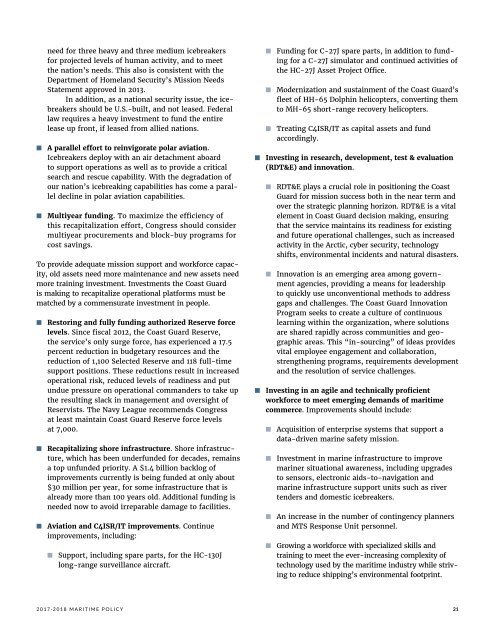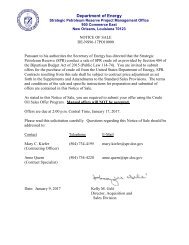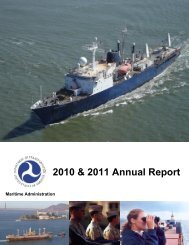Create successful ePaper yourself
Turn your PDF publications into a flip-book with our unique Google optimized e-Paper software.
need for three heavy and three medium icebreakers<br />
for projected levels of human activity, and to meet<br />
the nation’s needs. This also is consistent with the<br />
Department of Homeland Security’s Mission Needs<br />
Statement approved in 2013.<br />
In addition, as a national security issue, the icebreakers<br />
should be U.S.-built, and not leased. Federal<br />
law requires a heavy investment to fund the entire<br />
lease up front, if leased from allied nations.<br />
n A parallel effort to reinvigorate polar aviation.<br />
Icebreakers deploy with an air detachment aboard<br />
to support operations as well as to provide a critical<br />
search and rescue capability. With the degradation of<br />
our nation’s icebreaking capabilities has come a parallel<br />
decline in polar aviation capabilities.<br />
n Multiyear funding. To maximize the efficiency of<br />
this recapitalization effort, Congress should consider<br />
multiyear procurements and block-buy programs for<br />
cost savings.<br />
To provide adequate mission support and workforce capacity,<br />
old assets need more maintenance and new assets need<br />
more training investment. Investments the Coast Guard<br />
is making to recapitalize operational platforms must be<br />
matched by a commensurate investment in people.<br />
n Restoring and fully funding authorized Reserve force<br />
levels. Since fiscal 2012, the Coast Guard Reserve,<br />
the service’s only surge force, has experienced a 17.5<br />
percent reduction in budgetary resources and the<br />
reduction of 1,100 Selected Reserve and 118 full-time<br />
support positions. These reductions result in increased<br />
operational risk, reduced levels of readiness and put<br />
undue pressure on operational commanders to take up<br />
the resulting slack in management and oversight of<br />
Reservists. The Navy League recommends Congress<br />
at least maintain Coast Guard Reserve force levels<br />
at 7,000.<br />
n Recapitalizing shore infrastructure. Shore infrastructure,<br />
which has been underfunded for decades, remains<br />
a top unfunded priority. A $1.4 billion backlog of<br />
improvements currently is being funded at only about<br />
$30 million per year, for some infrastructure that is<br />
already more than 100 years old. Additional funding is<br />
needed now to avoid irreparable damage to facilities.<br />
n Aviation and C4ISR/IT improvements. Continue<br />
improvements, including:<br />
n Support, including spare parts, for the HC-130J<br />
long-range surveillance aircraft.<br />
n Funding for C-27J spare parts, in addition to funding<br />
for a C-27J simulator and continued activities of<br />
the HC-27J Asset Project Office.<br />
n Modernization and sustainment of the Coast Guard’s<br />
fleet of HH-65 Dolphin helicopters, converting them<br />
to MH-65 short-range recovery helicopters.<br />
n Treating C4ISR/IT as capital assets and fund<br />
accordingly.<br />
n Investing in research, development, test & evaluation<br />
(RDT&E) and innovation.<br />
n RDT&E plays a crucial role in positioning the Coast<br />
Guard for mission success both in the near term and<br />
over the strategic planning horizon. RDT&E is a vital<br />
element in Coast Guard decision making, ensuring<br />
that the service maintains its readiness for existing<br />
and future operational challenges, such as increased<br />
activity in the Arctic, cyber security, technology<br />
shifts, environmental incidents and natural disasters.<br />
n Innovation is an emerging area among government<br />
agencies, providing a means for leadership<br />
to quickly use unconventional methods to address<br />
gaps and challenges. The Coast Guard Innovation<br />
Program seeks to create a culture of continuous<br />
learning within the organization, where solutions<br />
are shared rapidly across communities and geographic<br />
areas. This “in-sourcing” of ideas provides<br />
vital employee engagement and collaboration,<br />
strengthening programs, requirements development<br />
and the resolution of service challenges.<br />
n Investing in an agile and technically proficient<br />
workforce to meet emerging demands of maritime<br />
commerce. Improvements should include:<br />
n Acquisition of enterprise systems that support a<br />
data-driven marine safety mission.<br />
n Investment in marine infrastructure to improve<br />
mariner situational awareness, including upgrades<br />
to sensors, electronic aids-to-navigation and<br />
marine infrastructure support units such as river<br />
tenders and domestic icebreakers.<br />
n An increase in the number of contingency planners<br />
and MTS Response Unit personnel.<br />
n Growing a workforce with specialized skills and<br />
training to meet the ever-increasing complexity of<br />
technology used by the maritime industry while striving<br />
to reduce shipping’s environmental footprint.<br />
2017-2018 <strong>MARITIME</strong> POLICY 21




